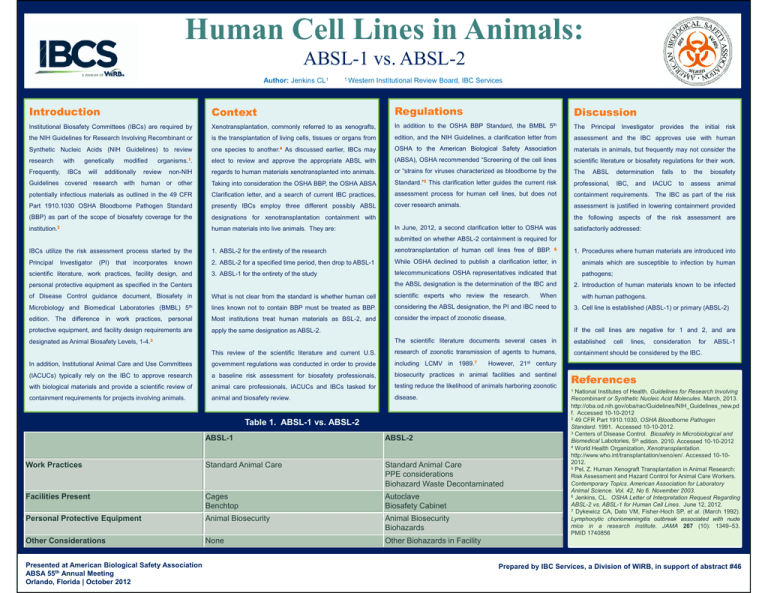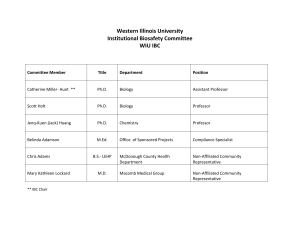Human Cell Lines in Animals: ABSL-1 vs. ABSL-2 Regulations Introduction
advertisement

Human Cell Lines in Animals: ABSL-1 vs. ABSL-2 Author: Jenkins CL1 Introduction 1 Western Context Institutional Review Board, IBC Services Regulations Discussion 5th Institutional Biosafety Committees (IBCs) are required by Xenotransplantation, commonly referred to as xenografts, In addition to the OSHA BBP Standard, the BMBL the NIH Guidelines for Research Involving Recombinant or is the transplantation of living cells, tissues or organs from edition, and the NIH Guidelines, a clarification letter from S th ti Nucleic Synthetic N l i Acids A id (NIH Guidelines) G id li ) to t review i one species i t another. to th 4 As A discussed di d earlier, li IBC may IBCs OSHA to the American Biological Safety Association materials t i l in i animals, i l but b t frequently f tl may nott consider id the th organisms.1. elect to review and approve the appropriate ABSL with (ABSA), OSHA recommended “Screening of the cell lines scientific literature or biosafety regulations for their work. research with genetically modified The Principal Investigator provides the initial risk assessment and the IBC approves use with human non-NIH regards to human materials xenotransplanted into animals. or “strains for viruses characterized as bloodborne by the The Guidelines covered research with human or other Taking into consideration the OSHA BBP, the OSHA ABSA Standard.”5 This clarification letter guides the current risk professional, potentially infectious materials as outlined in the 49 CFR Clarification letter, and a search of current IBC practices, assessment process for human cell lines, but does not containment requirements. The IBC as part of the risk Part 1910.1030 OSHA Bloodborne Pathogen Standard presently IBCs employ three different possibly ABSL cover research animals. assessment is justified in lowering containment provided (BBP) as part of the scope of biosafety coverage for the designations for xenotransplantation containment with institution.2 human materials into live animals. They are: Frequently, IBCs will additionally review ABSL determination IBC, and falls IACUC to to the assess biosafety animal the following aspects of the risk assessment are In June, 2012, a second clarification letter to OSHA was satisfactorily addressed: submitted on whether ABSL-2 containment is required for IBCs utilize the risk assessment process started by the 1. ABSL-2 for the entirety of the research xenotransplantation of human cell lines free of BBP. 6 1. Procedures where human materials are introduced into Principal 2. ABSL-2 for a specified time period, then drop to ABSL-1 While OSHA declined to publish a clarification letter, in animals which are susceptible to infection by human 3. ABSL-1 for the entirety of the study telecommunications OSHA representatives indicated that Investigator (PI) that incorporates known scientific literature, work practices, facility design, and the ABSL designation is the determination of the IBC and personal protective equipment as specified in the Centers of Disease Control guidance document, document Biosafety in What is not clear from the standard is whether human cell scientific experts who review the research. research Microbiology and Biomedical Laboratories (BMBL) 5th lines known not to contain BBP must be treated as BBP. considering the ABSL designation, the PI and IBC need to When edition. The difference in work practices, personal Most institutions treat human materials as BSL-2, and consider the impact of zoonotic disease, protective equipment, and facility design requirements are apply the same designation as ABSL-2. pathogens; 2. Introduction of human materials known to be infected with human pathogens. pathogens 3. Cell line is established (ABSL-1) or primary (ABSL-2) If the cell lines are negative for 1 and 2, and are The scientific literature documents several cases in established This review of the scientific literature and current U.S. research of zoonotic transmission of agents to humans, containment should be considered by the IBC. In addition, Institutional Animal Care and Use Committees government regulations was conducted in order to provide including LCMV in 1989.7 (IACUCs) typically rely on the IBC to approve research a baseline risk assessment for biosafety professionals, biosecurity practices in animal facilities and sentinel with biological materials and provide a scientific review of animal care professionals, IACUCs and IBCs tasked for testing reduce the likelihood of animals harboring zoonotic containment requirements for projects involving animals. animal and biosafety review. disease. designated as Animal Biosafety Levels, 1-4.3 lines, consideration for ABSL-1 However, 21st century Table 1. ABSL-1 vs. ABSL-2 ABSL-1 ABSL-2 Work Practices Standard Animal Care Standard Animal Care PPE considerations Biohazard Waste Decontaminated Facilities Present Cages Benchtop Autoclave Biosafety Cabinet Personal Protective Equipment Animal Biosecurity Animal Biosecurity Biohazards Other Considerations None Other Biohazards in Facility Presented at American Biological Safety Association ABSA 55th Annual Meeting Orlando, Florida | October 2012 cell References 1 National Institutes of Health. Guidelines for Research Involving Recombinant or Synthetic Nucleic Acid Molecules. March, 2013. http://oba.od.nih.gov/oba/rac/Guidelines/NIH_Guidelines_new.pd f. Accessed 10-10-2012 2 49 CFR Part 1910.1030, OSHA Bloodborne Pathogen Standard. 1991. Accessed 10-10-2012. 3 Centers of Disease Control. Biosafety in Microbiological and Biomedical Labotories, 5th edition. 2010. Accessed 10-10-2012 4 World Health Organization, Xenotransplantation. http://www.who.int/transplantation/xeno/en/. Accessed 10-102012. 5 Pel, Z. Human Xenograft Transplantation in Animal Research: Risk Assessment and Hazard Control for Animal Care Workers. Contemporary Topics. American Association for Laboratory Animal Science. Vol. 42, No 6. November 2003. 6 Jenkins, CL. OSHA Letter of Interpretation Request Regarding ABSL-2 vs. ABSL-1 for Human Cell Lines. June 12, 2012. 7 Dykewicz CA, Dato VM, Fisher-Hoch SP, et al. (March 1992). Lymphocytic choriomeningitis outbreak associated with nude mice in a research institute. JAMA 267 (10): 1349–53. PMID 1740856 Prepared by IBC Services, a Division of WIRB, in support of abstract #46



